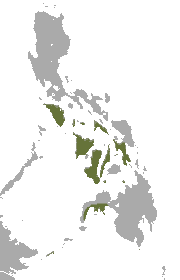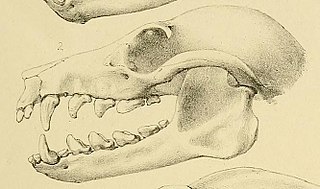
The giant golden-crowned flying fox, also known as the golden-capped fruit bat, is a species of megabat endemic to the Philippines. Since its description in 1831, three subspecies of the giant golden-crowned flying fox have been recognized, one of which is extinct. The extinct subspecies was formerly recognized as a full species, the Panay golden-crowned flying fox. Formerly, this species was placed in the genus Pteropus; while it is no longer within the genus, it has many physical similarities to Pteropus megabats. It is one of the largest bat species in the world, weighing up to 1.4 kg (3.1 lb)—only the Indian and great flying fox can weigh more. It has the longest documented forearm length of any bat species at 21 cm (8.3 in).

The Moluccan flying fox, also known as the Ambon flying fox, is a species of megabat in the genus Pteropus.

The gray flying fox is a species of flying fox in the family Pteropodidae. It is not to be confused with the Grey-headed flying fox. It is found in Indonesia, but not in the Philippines, despite occasional reference to such. Very little is known about this species. The gray flying fox has small size and neutral coloration with a brownish head and an orange abdomen. It probably roosts individually or in small groups. It was listed on appendix II of CITES, and is classified as "Data Deficient" by the IUCN. This species has been decimated by hunting for bushmeat in Indonesia. The hunters use fishing hooks, ropes, and other supplies to hunt the bats. The ropes and hooks are placed along their flight paths, tearing and ensnaring the bats' wings when are flying. In the course of a hunting season, entire colonies can be killed.

The Lombok flying fox is a species of megabat in the genus Pteropus. It is endemic to Indonesia. This species has been listed on Appendix II of CITES since 1990, along with most others in the genus Pteropus. It was classified as "Least Concern" by the IUCN in 1996, but was changed to "Data Deficient" in 2008 due to uncertainty of the abundance and possible threats from hunting and habitat destruction.

The Caroline flying fox or Pohnpei flying fox is a species of megabat in the genus Pteropus, endemic to Micronesia. Its natural habitat is subtropical or tropical dry forests. Prior to a ban on commercial exploitation, it was hunted for export, substantially impacting its abundance. It is threatened by habitat loss due to expanding plantations.

The great flying fox, also known as the greater flying fox or Bismarck flying fox, is a species of megabat in the genus Pteropus, found throughout lowland areas of New Guinea and in the Bismarck Archipelago. Conflicting evidence suggests that its closest relative is either the spectacled flying fox or, jointly, the Pelew and insular flying foxes. Two subspecies are recognized. At up to 1.6 kg (3.5 lb) in weight, it is among the heaviest bats in the world and the largest bat in Melanesia. It is a gregarious animal which roosts with hundreds or thousands of individuals. In part due to its wide variation in color, it has many taxonomic synonyms, including Pteropus degener, Pteropus papuanus, and Pteropus sepikensis. It may forage during the day or night in search of fruit, including figs or fruits from the family Sapotaceae. It is considered a least-concern species by the IUCN, though its numbers have been negatively impacted by what appeared to be a disease, as well as by hunting for bushmeat that occurs across its range.

The ornate flying fox is a species of flying fox in the family Pteropodidae. It is endemic to New Caledonia. Its natural habitat is subtropical or tropical dry forests. It is threatened due to habitat destruction and hunting, the former exacerbated by high roost-site fidelity.

Pteropus pelagicus is a species of fruit bat in the family Pteropodidae. It includes two subspecies that were formerly recognized as full species— Pteropus insularis and Pteropus phaeocephalus. It is endemic to Micronesia. It is threatened by habitat loss.

The Geelvink Bay flying fox or Geelvink Bay fruit bat is a species of flying fox in the family Pteropodidae. It is endemic to the islands of Yapen, Numfor, and Rani, which lie north of New Guinea in Indonesia's Papua Province. The name comes from Geelvink Bay, now Cenderawasih Bay.

The little golden-mantled flying fox is a species of bat in the family Pteropodidae. It is found in Indonesia and the Philippines. Its natural habitat is subtropical or tropical dry forests.

The Madagascan flying fox, Madagascar flying-fox, or Madagascar fruit bat is a species of megabat in the genus Pteropus. It is endemic to Madagascar. Its natural habitats are diverse, and include moist lowland forests, dry forests, succulent woodlands, and spiny thickets, and mangroves. It eats figs and other fruits, flowers, and leaves. It is threatened by habitat loss.

The Samoa flying fox or Samoan flying fox is a species of flying fox in the family Pteropodidae. It is found in American Samoa, Fiji, and Samoa. Its natural habitat is subtropical or tropical dry forests.

Temminck's flying fox is a species of flying fox in the family Pteropodidae. It is found in Indonesia. The species was classified as "Vulnerable" in 2008 by the IUCN due to threats from habitat destruction and hunting.

The insular flying fox or Pacific flying fox is a species of flying fox in the family Pteropodidae. It is geographically widespread, the most widespread flying fox in the Pacific: it is found in American Samoa, the Cook Islands, Fiji, New Caledonia, Niue, Papua New Guinea, Samoa, the Solomon Islands, Tonga, and Vanuatu.

The Vanikoro flying fox, also known locally as the basapine, is a species of bat in the family Pteropodidae. It has only been found in the Vanikoro island group located in the southern Solomon Islands. The species as a whole was originally known from just a few specimens collected sometime before 1930 but following surveys conducted on the island in the early 1990s did not detect this species again causing the Vanikoro flying fox to be listed as extinct. However, the species was rediscovered by a survey conducted in late 2014 which indicated a population in the high hundreds or low thousands and reported all observations.

The New Caledonia flying fox is a species of flying fox in the family Pteropodidae. It is endemic to New Caledonia. The habitat of the species is highly fragmented, and possibly decreasing due to deforestation. Other threats such as hunting are as yet unquantified.

The Aru flying fox is a Critically Endangered species of megabat found in the Aru Islands in Indonesia. It was described by Wilhelm Peters in 1867. It was formerly considered a subspecies of the black-bearded flying fox. The species is poorly known, and has not been encountered since the 19th century. It is classified as critically endangered by the IUCN and is listed on CITES appendix II.

The Makira flying fox is a species of megabat in the genus Pteropus, found in the Solomon Islands. The species is currently decreasing and is endangered due to threats from logging and hunting. In 2013, Bat Conservation International listed this species as one of the 35 species of its worldwide priority list of conservation.

The Rennell flying fox is a species of flying fox found in the Solomon Islands. It is an endangered species risking extinction.

The Yap tropical dry forests is a tropical and subtropical dry broadleaf forests ecoregion in Micronesia. It includes the Yap Islands and neighboring atolls in the Federated States of Micronesia.






















